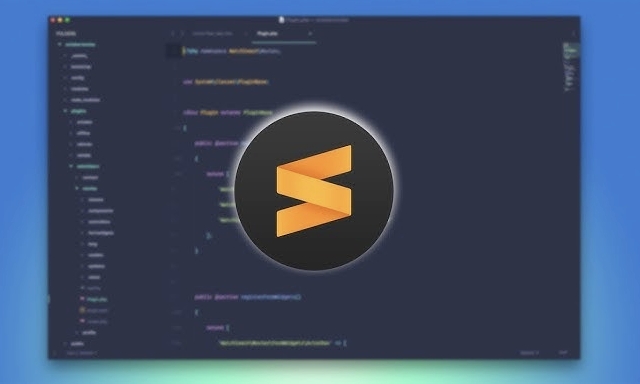Sublime Text auto close HTML tags
Jul 30, 2025 am 02:41 AMInstalling the Emmet plug-in can achieve intelligent automatic closing of tags and support abbreviation syntax; 2. Enable "auto_match_enabled": true to enable Sublime to automatically complete simple tags; 3. Use Alt . (Win) or Ctrl Shift . (Mac) shortcut keys to manually close the current tag - it is recommended to use Emmet on a daily basis. The latter two methods can be combined, which is efficient and simple to set.

Sublime Text does not automatically close HTML tags like some IDEs such as VS Code, but you can easily implement this feature in several ways to make writing HTML more efficient.

? Method 1: Install the plug-in— Emmet
This is the most commonly used and recommended method.
- Open Sublime Text.
- Press
Ctrl Shift P(Cmd Shift Pon Mac) to open the command panel. - Enter
Package Control: Install Packageand press Enter. - Search and install Emmet .
- After the installation is complete, enter the following:
div>p*3
Then press
Taband it will automatically expand into:
<div> <p></p> <p></p> <p></p> </div>
? Emmet will automatically complete the tag closure for you, and supports abbreviation grammar, which is extremely efficient.
? Method 2: Enable Sublime’s built-in automatic pairing function
Make sure that the automatic closing function that comes with Sublime is enabled:

- Go to menu:
Preferences > Settings - Add or confirm in the right panel (user settings) there are:
{ "auto_match_enabled": true }This will allow Sublime to automatically fill in
after you type in<div> (in some cases).<p> ?? Note: This function is not as intelligent as Emmet, and it is only effective when entering simple tags, and complex nesting still requires Emmet.</p> <hr> <h3 id="Method-optional-Use-shortcut-keys-to-manually-close-it"> ? Method 3 (optional): Use shortcut keys to manually close it</h3> <p> If you don't want to rely on plug-ins, you can quickly close the current tag with the shortcut keys included with Sublime:</p> <ul> <li> Enter the start tag such as <code><section></section> - Press
Alt .(Windows/Linux) orCtrl Shift .(Mac) - It will automatically insert the corresponding closed tag
- It is highly recommended to install Emmet for daily writing of HTML. It not only automatically closes, but also greatly improves coding efficiency.
- If you just write labels occasionally, use the built-in
auto_match_enabledshortcutAlt .
? This shortcut key is very practical for fast closing of single tags, and is suitable for lightweight users who do not want to install plug-ins.
Summarize:
Basically all that is, not complicated but easy to ignore the settings details?
The above is the detailed content of Sublime Text auto close HTML tags. For more information, please follow other related articles on the PHP Chinese website!

Hot AI Tools

Undress AI Tool
Undress images for free

Undresser.AI Undress
AI-powered app for creating realistic nude photos

AI Clothes Remover
Online AI tool for removing clothes from photos.

Clothoff.io
AI clothes remover

Video Face Swap
Swap faces in any video effortlessly with our completely free AI face swap tool!

Hot Article

Hot Tools

Notepad++7.3.1
Easy-to-use and free code editor

SublimeText3 Chinese version
Chinese version, very easy to use

Zend Studio 13.0.1
Powerful PHP integrated development environment

Dreamweaver CS6
Visual web development tools

SublimeText3 Mac version
God-level code editing software (SublimeText3)

Hot Topics
 VSCode settings.json location
Aug 01, 2025 am 06:12 AM
VSCode settings.json location
Aug 01, 2025 am 06:12 AM
The settings.json file is located in the user-level or workspace-level path and is used to customize VSCode settings. 1. User-level path: Windows is C:\Users\\AppData\Roaming\Code\User\settings.json, macOS is /Users//Library/ApplicationSupport/Code/User/settings.json, Linux is /home//.config/Code/User/settings.json; 2. Workspace-level path: .vscode/settings in the project root directory
 How to handle transactions in Java with JDBC?
Aug 02, 2025 pm 12:29 PM
How to handle transactions in Java with JDBC?
Aug 02, 2025 pm 12:29 PM
To correctly handle JDBC transactions, you must first turn off the automatic commit mode, then perform multiple operations, and finally commit or rollback according to the results; 1. Call conn.setAutoCommit(false) to start the transaction; 2. Execute multiple SQL operations, such as INSERT and UPDATE; 3. Call conn.commit() if all operations are successful, and call conn.rollback() if an exception occurs to ensure data consistency; at the same time, try-with-resources should be used to manage resources, properly handle exceptions and close connections to avoid connection leakage; in addition, it is recommended to use connection pools and set save points to achieve partial rollback, and keep transactions as short as possible to improve performance.
 python itertools combinations example
Jul 31, 2025 am 09:53 AM
python itertools combinations example
Jul 31, 2025 am 09:53 AM
itertools.combinations is used to generate all non-repetitive combinations (order irrelevant) that selects a specified number of elements from the iterable object. Its usage includes: 1. Select 2 element combinations from the list, such as ('A','B'), ('A','C'), etc., to avoid repeated order; 2. Take 3 character combinations of strings, such as "abc" and "abd", which are suitable for subsequence generation; 3. Find the combinations where the sum of two numbers is equal to the target value, such as 1 5=6, simplify the double loop logic; the difference between combinations and arrangement lies in whether the order is important, combinations regard AB and BA as the same, while permutations are regarded as different;
 Mastering Dependency Injection in Java with Spring and Guice
Aug 01, 2025 am 05:53 AM
Mastering Dependency Injection in Java with Spring and Guice
Aug 01, 2025 am 05:53 AM
DependencyInjection(DI)isadesignpatternwhereobjectsreceivedependenciesexternally,promotingloosecouplingandeasiertestingthroughconstructor,setter,orfieldinjection.2.SpringFrameworkusesannotationslike@Component,@Service,and@AutowiredwithJava-basedconfi
 python pytest fixture example
Jul 31, 2025 am 09:35 AM
python pytest fixture example
Jul 31, 2025 am 09:35 AM
fixture is a function used to provide preset environment or data for tests. 1. Use the @pytest.fixture decorator to define fixture; 2. Inject fixture in parameter form in the test function; 3. Execute setup before yield, and then teardown; 4. Control scope through scope parameters, such as function, module, etc.; 5. Place the shared fixture in conftest.py to achieve cross-file sharing, thereby improving the maintainability and reusability of tests.
 A Guide to Java Flight Recorder (JFR) and Mission Control
Jul 31, 2025 am 04:42 AM
A Guide to Java Flight Recorder (JFR) and Mission Control
Jul 31, 2025 am 04:42 AM
JavaFlightRecorder(JFR)andJavaMissionControl(JMC)providedeep,low-overheadinsightsintoJavaapplicationperformance.1.JFRcollectsruntimedatalikeGCbehavior,threadactivity,CPUusage,andcustomeventswithlessthan2%overhead,writingittoa.jfrfile.2.EnableJFRatsta
 Python for Data Engineering ETL
Aug 02, 2025 am 08:48 AM
Python for Data Engineering ETL
Aug 02, 2025 am 08:48 AM
Python is an efficient tool to implement ETL processes. 1. Data extraction: Data can be extracted from databases, APIs, files and other sources through pandas, sqlalchemy, requests and other libraries; 2. Data conversion: Use pandas for cleaning, type conversion, association, aggregation and other operations to ensure data quality and optimize performance; 3. Data loading: Use pandas' to_sql method or cloud platform SDK to write data to the target system, pay attention to writing methods and batch processing; 4. Tool recommendations: Airflow, Dagster, Prefect are used for process scheduling and management, combining log alarms and virtual environments to improve stability and maintainability.
 Best Practices for Writing Maintainable Java Code
Jul 31, 2025 am 06:21 AM
Best Practices for Writing Maintainable Java Code
Jul 31, 2025 am 06:21 AM
Follow naming specifications to make the code as easy to read as prose; 2. The method should be small and focused, and a single responsibility is easy to test and reuse; 3. Write meaningful comments to explain "why", rather than obvious operations; 4. Prioritize immutability and packaging to prevent external accidental modifications; 5. Exceptions should be properly handled without ignoring and providing clear information; 6. Unit tests should be clearly named and cover key paths; 7. Reasonable use of modern Java features such as var and Stream to improve readability; 8. Organization of package structures layered by functions to improve project navigation efficiency - these practices jointly ensure that Java code is maintained for a long time.






